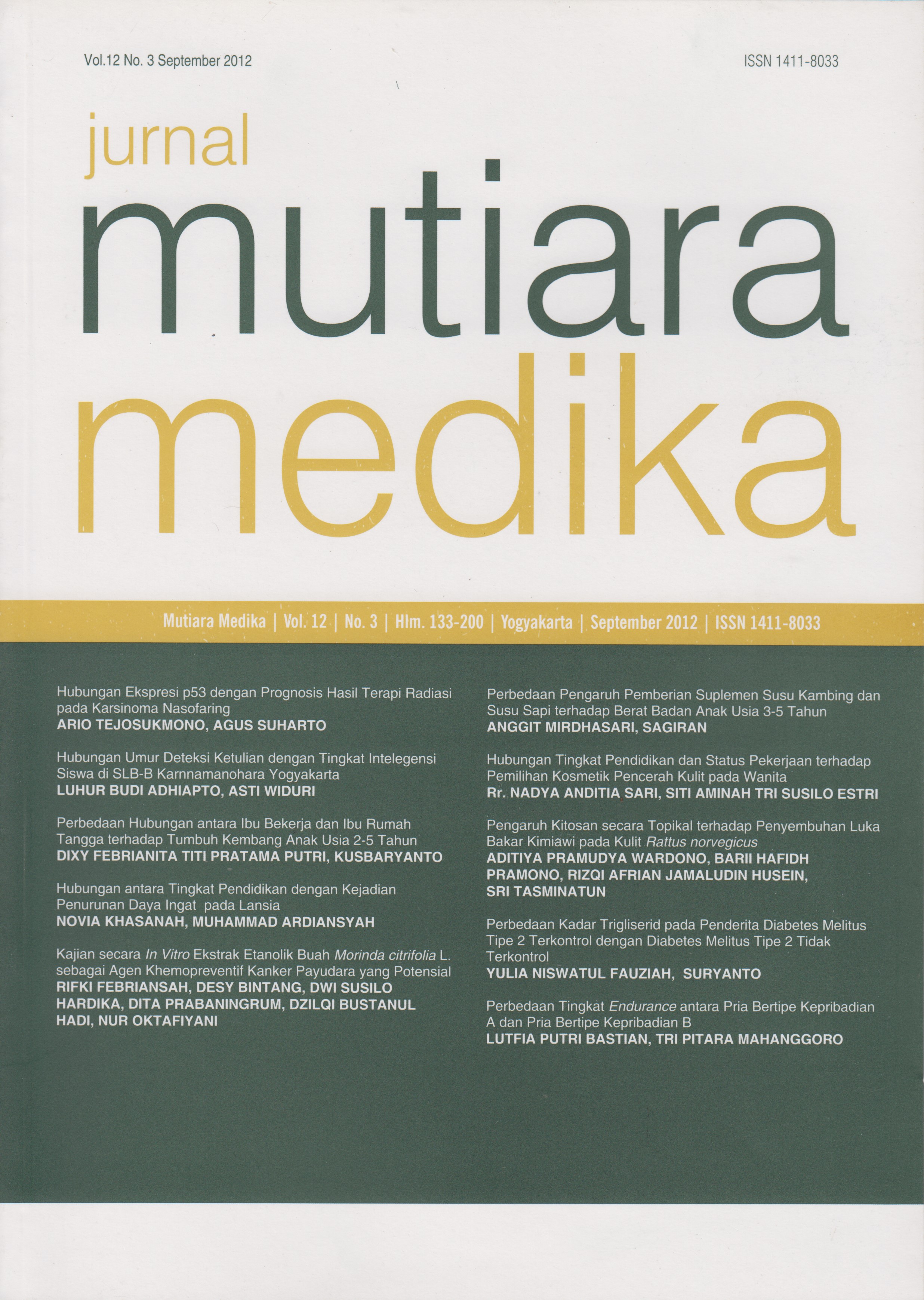Hubungan Tingkat Pendidikan dan Status Pekerjaan terhadap Pemilihan Kosmetik Pencerah Kulit pada Wanita
DOI:
https://doi.org/10.18196/mmjkk.v12i3.1045Keywords:
kosmetik pencerah kulit, pekerjaan, pendidikan, wanita, skin lightening cosmetics, occupation, education, womanAbstract
Jenis kosmetika yang banyak dipakai saat ini ialah kosmetika jenis pencerah kulit atau lightening cream. Pemilihan pemakaian kosmetik pencerah kulit membutuhkan pemikiran yang kritis sebelum menggunakannya karena efek sampingnya. Penelitian ini bertujuan untuk mengetahui hubungan antara tingkat pendidikan dan status pekerjaan terhadap pemilihan produk pencerah kulit pada wanita. Penelitian merupakan penelitian non-eksperimental dengan pendekatan cross sectional di Desa Tamantirto, Dusun I Geblakan RW 01 RT 04 Tegalwangi Bantul. Sampel penelitian ini adalah wanita berusia 22-55 tahun yang sudah menikah yang ada atau menetap pada dusun tersebut sebanyak 32 orang yang memenuhi kriteria inklusi dan eksklusi. Analisis uji korelasi Spearman menunjukkan adanya hubungan negatif lemah (r= -0,056) yang tidak signifikan dengan nilai p = 0,761 (p>0,05) antara tingkat pendidikan dengan perilaku pemilihan produk pencerah kulit pada wanita, sedangkan uji korelasi Spearman menunjukkan adanya hubungan positif kuat (r = 0,460) yang signifikan dengan nilai p=0,008 (p<0,05) antara status pekerjaan dengan perilaku pemilihan produk pencerah kulit pada wanita. Disimpulkan bahwa tingkat pendidikan seseorang tidak menentukan perilaku pemilihan produk pencerah kulit pada seseorang seutuhnya. Status pekerjaan seseorang menentukan perilaku pemiilihan produk pencerah kulit di mana wanita yang bekerja lebih banyak menggunakan produk pencerah kulit daripada wanita yang tidak bekerja.
Types of cosmetics that is widely used today is kind of lightening cosmetics or skin lightening cream. The selection of skin lightening cosmetics usage requires critical thinking before using it because of its side effects. This study aims to determine the relationship between educational levels and occupational status of skin lightening product selection in women. This study is a non-experimental, cross sectional approach undertaken in the village of Tamantirto, Hamlet I Geblakan RW 01 RT 04, Bantul, Yogyakarta. Samples were taken from women aged 22-55 years who are married or who have settled in the hamlet of 32 people who meet the criteria for inclusion and exclusion. Spearman correlation test analyze showed that there was poor negative correlation (r= -0,056) which wasn’t significant with p value=0,761 (p>0,05) between educational level and enlightenment skin cosmetic electoral behavior in women. While Spearman correlation test analyze showed that there was strong positive correlation (r= 0,460) which was significant with p value=0,008 (p<0,05) between employment statues and enlightenment skin cosmetic electoral behavior in women. It was concluded that educational level of someone doesn’t determine enlightenment skin cosmetic electoral behavior in someone completely. Employment statues of someone determines enlightenment skin cosmetic electoral behavior where employed women uses skin lightening cosmetic more than unemployed women.
References
Zulkarnain, I. Kosmetika Pemutih Kulit dan Permasalahannya. 2008. Diakses 3 April 2009 dari http://ojs.lib.unair.ac.id/index.php/bipkk/ article/view/152/152
Suarni. Survey Produk Pemutih Kulit di Pasaran. 2005. Diakses 4 april 2009 dari http://www. pikiran-rakyat.com/cetak/2005/0805/21/ hikmah/lainnya4.htm
Browns, R.G., Burns, T. Lecture Notes on Dermatology (A. Zakaria, Trans.). Jakarta: Penerbit Erlangga. 2005. (original work published 2002).
Meilisa, N. Iklan Kosmetik Pemutih Kulit: Persepsi dan Ekspektasi Pengguna serta Tinjauan Etis Menurut Tata Krama Periklanan Indonesia. Skripsi Strata Satu, Universitas Kristen Petra. 2006.
Emilia, O. Promosi Kesehatan dalam Lingkup Kesehatan Reproduksi. Yogyakarta: Pustaka Cendekia Press. 2009.
Hartoto. Pendidikan dan Hubungan antar Kelompok. Makalah Sosiologi Pendidikan. Universitas Negeri Makassar. 2008.
Badan Pusat Statistik Kota Sibolga. Statistik Tenaga Kerja Sibolga. Sumatera Utara: BPS Sibolga. 2007.
Sastroasmoro, S., Ismael, S. Dasar-dasar Metodologi Penelitian Klinis. Jakarta: sagung seto. 2002.
Notoatmodjo, S. Promosi Kesehatan dan Ilmu Perilaku. Jakarta: Rineka Cipta. 2007.
Mai, N.H., Sirikhoon, S. Cosmetic Market in Vietnam. Tesis Strata Dua, Malardalen University. 2008.
Downloads
Published
Issue
Section
License
Copyright
Authors retain copyright and grant Mutiara Medika: Jurnal Kedokteran dan Kesehatan (MMJKK) the right of first publication with the work simultaneously licensed under an Attribution 4.0 International (CC BY 4.0) that allows others to remix, adapt and build upon the work with an acknowledgment of the work's authorship and of the initial publication in Mutiara Medika: Jurnal Kedokteran dan Kesehatan (MMJKK).
Authors are permitted to copy and redistribute the journal's published version of the work (e.g., post it to an institutional repository or publish it in a book), with an acknowledgment of its initial publication in Mutiara Medika: Jurnal Kedokteran dan Kesehatan (MMJKK).
License
Articles published in the Mutiara Medika: Jurnal Kedokteran dan Kesehatan (MMJKK) are licensed under an Attribution 4.0 International (CC BY 4.0) license. You are free to:
- Share — copy and redistribute the material in any medium or format.
- Adapt — remix, transform, and build upon the material for any purpose, even commercially.
This license is acceptable for Free Cultural Works. The licensor cannot revoke these freedoms as long as you follow the license terms. Under the following terms:
Attribution — You must give appropriate credit, provide a link to the license, and indicate if changes were made. You may do so in any reasonable manner, but not in any way that suggests the licensor endorses you or your use.
- No additional restrictions — You may not apply legal terms or technological measures that legally restrict others from doing anything the license permits.






